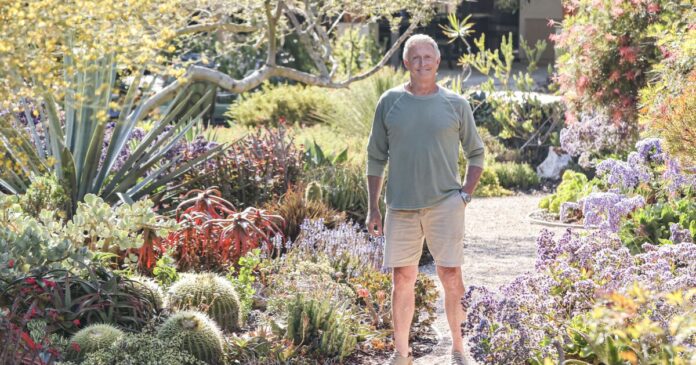Every April, the sprawling Mission Hills garden overlooking Heritage Park welcomes spring with a raucous cacophony of blossoms and fragrance, narrated by a chorus of trilling songbirds and chirping insects.
Beyond its spring explosion of blooms, the garden bursts with an ever-changing rainbow of color from both flowers and foliage throughout the year, with a palette traversing the color spectrum.
The now-mature garden represents the horticultural artistry of San Diego landscape designer and artist Randy Laurie, 64, owner/designer of Laurie’s Landscaping, known for his creativity and sensitivity to clients’ tastes and wishes.
“From fall to spring, the succulents are at their peak and the ice plants all take their turns blooming in oranges, yellows, purples, reds and pinks. From winter to spring the aloes follow, displaying spectacular bloom clusters on tall sturdy stalks. Some are shaped like a candelabra, some like a pagoda, and some are tube-shaped. Their colors are yellows, oranges, reds and corals. Proteas and Grevilleas provide gorgeous blooms and color nearly year-round. All these blooms are loved by the hummingbirds, the bees and other pollinators,” Laurie explained.
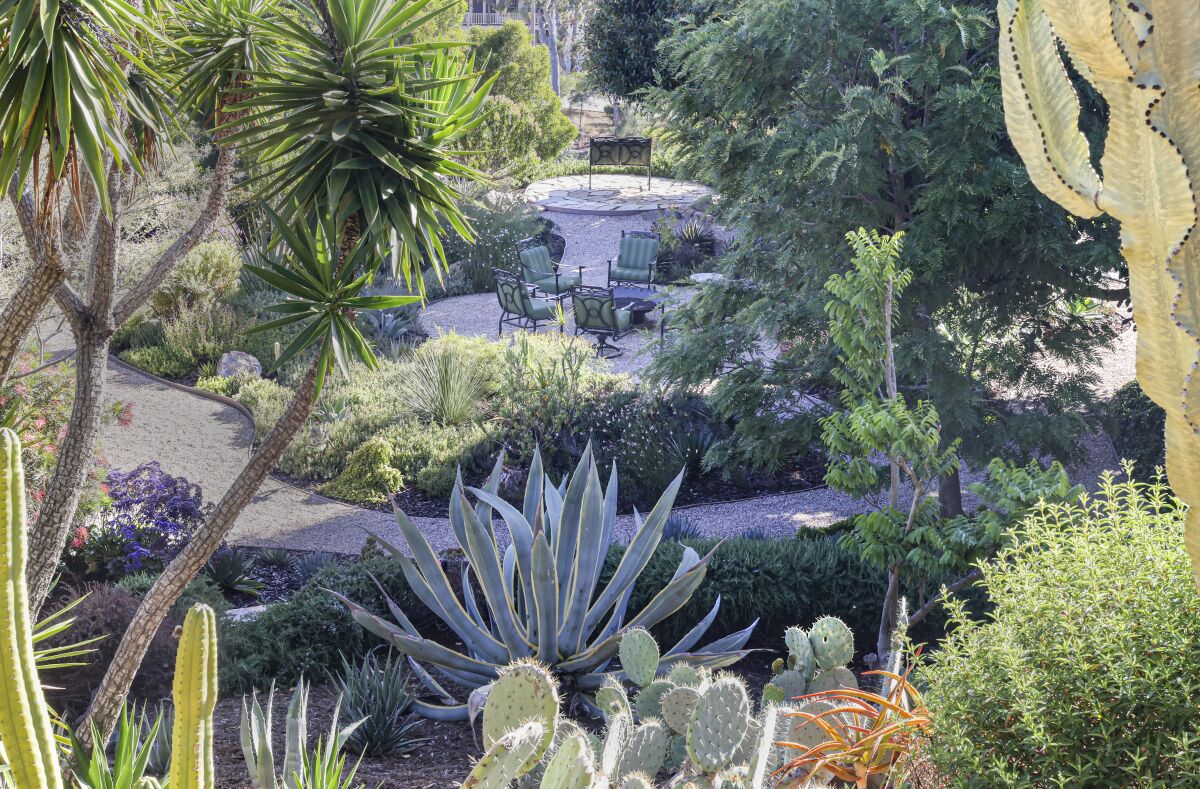
Paths wind throughout the garden, offering vantage points on multiple levels and five seating areas, making it ideal for entertaining.
(Eduardo Contreras / The San Diego Union-Tribune)
Laurie began working with the owners, who prefer to remain anonymous, about 2008. The owners, both committed hands-on gardeners, were longtime friends with Laurie and understood his artistic approach to horticulture. One is more in tune with plants, having grown up on a farm and enjoying gardening. The other, with a technical background, is fascinated with the mechanics of the garden, designing and installing sophisticated drainage systems throughout the property along with computer-controlled state-of-the-art drip irrigation and water emitters, ever-updated weather stations with rain predictors and an advanced programmable garden lighting system, spotlighting noteworthy trees and plants.
“This is a garden of the future. We’re testing all kinds of things, from soaker hoses to specialized water emitters and rotator heads. We’re trying to move everything to drip. I make sure everything works,” the technical partner explained. He’s particularly proud that, even as they expanded the garden, they reduced their water use by removing lawn, zoning their water applications and moving increasingly to drip irrigation.
They commissioned Laurie to design and install an eco-friendly, waterwise garden with predominantly drought-tolerant plants, year-round color, pops of fragrance and plants appealing to songbirds, bees, butterflies and other wildlife.
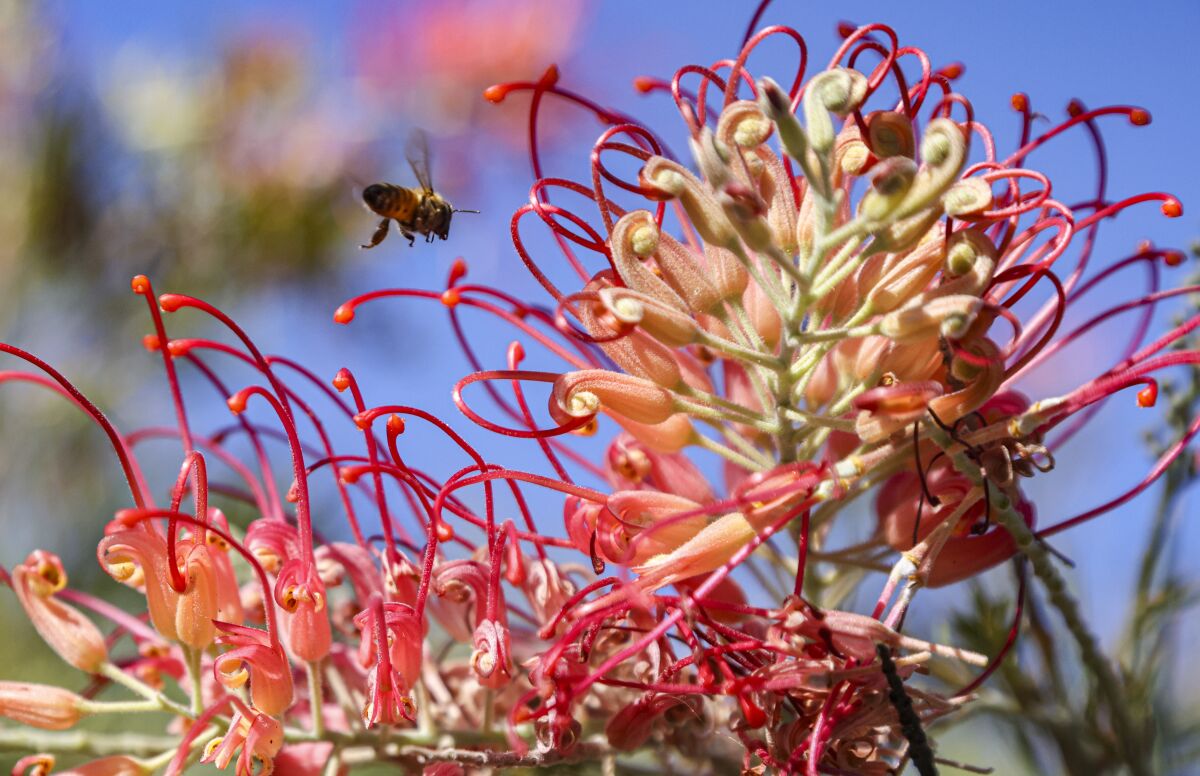
Plants like Grevillea ‘superb’ provide color and attract bees nearly year-round.
(Eduardo Contreras / The San Diego Union-Tribune)
They bought the property in 2000 and lived in the Spanish-style ranch house for several years while deciding how to remodel it. The original landscaping was simple, just a few trees, primarily ficus and pine, lots of yucca and a large lawn. Once they were able to acquire additional adjacent property, expanding to 2 full acres, their plans evolved and they opted to go for the immersive garden of their dreams. They encouraged Laurie to design meandering paths ideal for strolling and multiple seating areas where they could enjoy spectacular “golden hour” sunsets as well as the urban and coastal views extending through Mission Valley and Mission Bay.
From 2006 to 2008, the couple had moved out. Their design-build team took the house down to its studs and undertook a major remodel, creating a contemporary Mission-inspired house with Frank Lloyd Wright influences and bold horizontal and vertical lines. Their redesigned stone, wood, glass and stucco home flows directly into the garden via an extended indoor-outdoor living room and terrace incorporating an open-plan seating area and pool.
Once construction on the house ended, Laurie began by landscaping the house with magnolias, Euphorbias, dwarf weeping bottlebrush, coral aloe, Coreopsis, hybrid rosemary, purple lantana and sea lavender, along with a wide variety of succulents and other drought-tolerant plantings, many flowering.
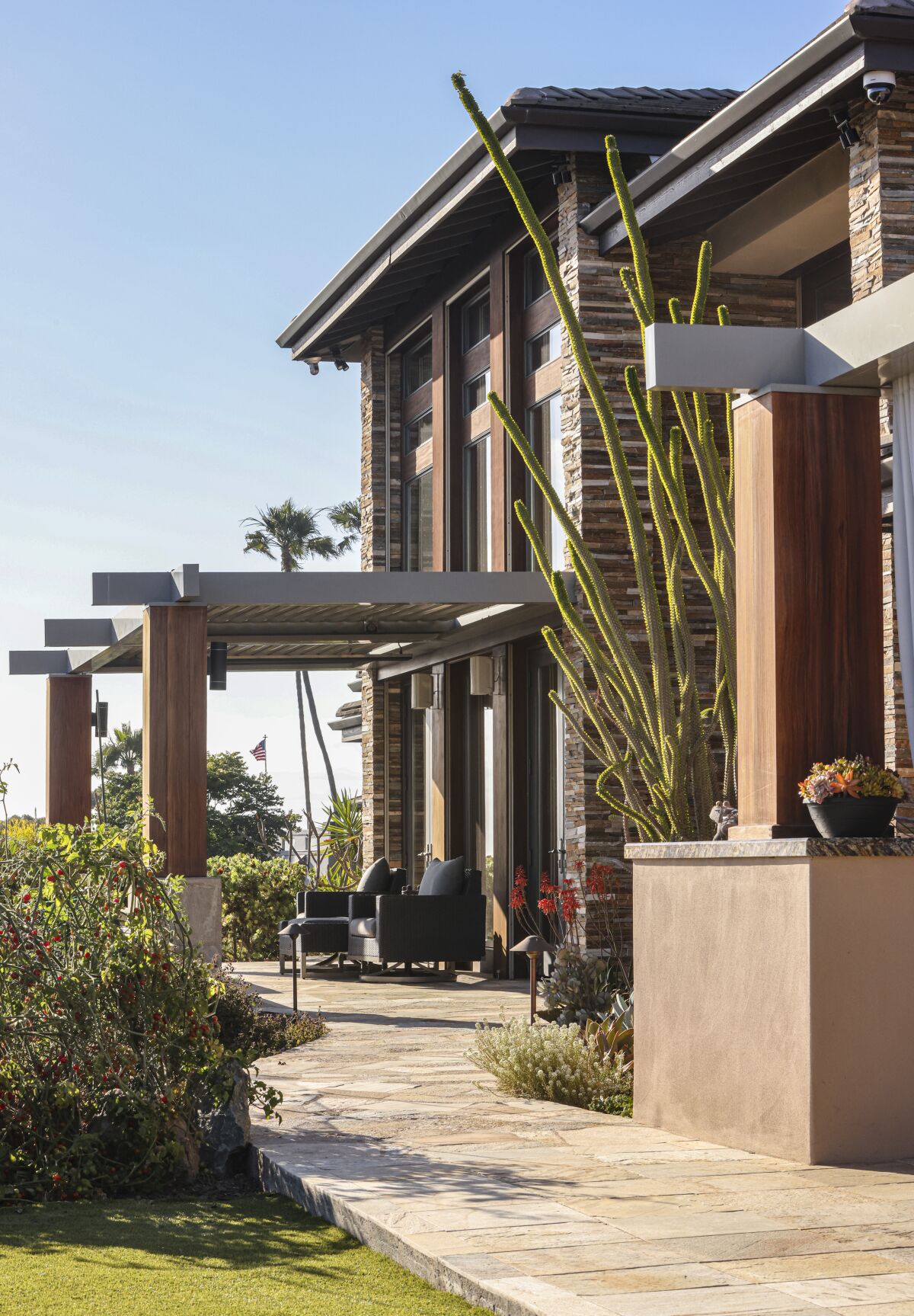
The home features bold horizontal and vertical lines; the garden design adds to this look with varying shapes, textures and colors.
(Eduardo Contreras / The San Diego Union-Tribune)
One of Laurie’s essential precepts in designing gardens is listening carefully to his clients, asking questions about their likes, dislikes, preferred colors and plants and any sentimental connections to plants, including childhood favorites.
“I can design around their likes and dislikes so they’ll be happy with the design,” he said.
In this case, one of the owners had fond childhood memories of magnolia trees, which he incorporated into the design. In addition, the couple took photos of appealing plants they discovered and shared them with Laurie.
“We went to a lot of botanical gardens on our travels. We went with Randy to Balboa Park and other gardens and looked at plants. Most everything we liked was drought-tolerant, with no tropical plants. We wanted everything waterwise,” one of the owners explained. “But the vision for the garden, that’s Randy’s. It’s his design, his vision. We didn’t give instructions about vision. He came up with a plan and has been executing it.”
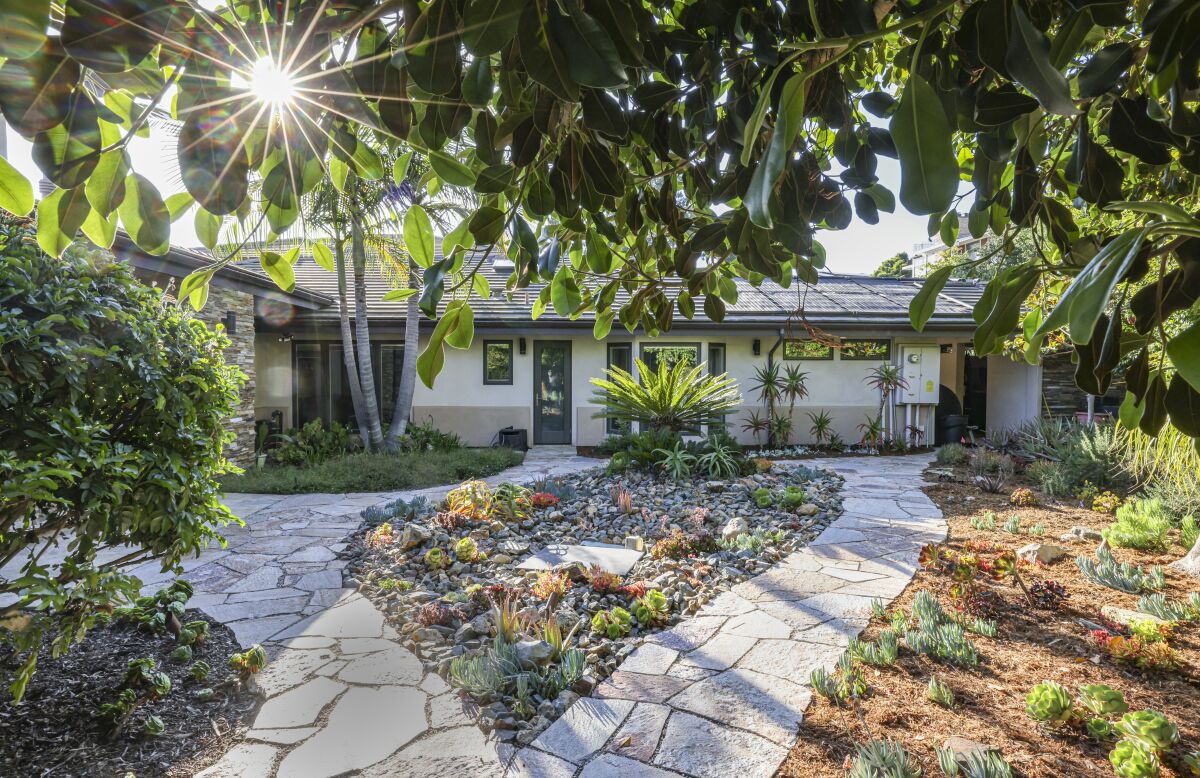
Randy Laurie said that in designing the garden, he wanted visitors to encounter something new and interesting around every corner, likening it to an art gallery.
(Eduardo Contreras / The San Diego Union-Tribune)
Aside from waterwise plants, their instructions to Laurie were relatively simple: They wanted a natural-looking, rather than a manicured, garden with as much color as possible, year-round, and with every color imaginable. They also wanted plants that would benefit the environment and attract wildlife, while providing nectar to pollinators and food for birds and other wildlife. They stressed being good neighbors, wanting to remove the existing tall pine trees that blocked neighbors’ views and avoiding any future problematical plantings.
“Once I got a really good idea of what they liked, I analyzed the space and decided where I’d put pathways and viewing and seating areas. Then I started with mass spatial relationships and proportions. I felt that was a special responsibility for this garden. It was a lot of space for people to enjoy. Even though this is a private garden, the owners are very gracious in sharing it for special events and garden tours. I wanted it to mature well and still look as good in 25 years as in three years. I felt they would value the garden and be good stewards.”
As part of the garden plan, but before the start of its installation about 2008, the owners built up the swale along the relocated long driveway, creating a dramatic backdrop for the eventual garden. They located dirt from construction sites and brought in 300 dump trucks containing 3,000 cubic yards of dirt to shape a hillside with a 45-degree slope, with the house and garden situated at the bottom of the slope.
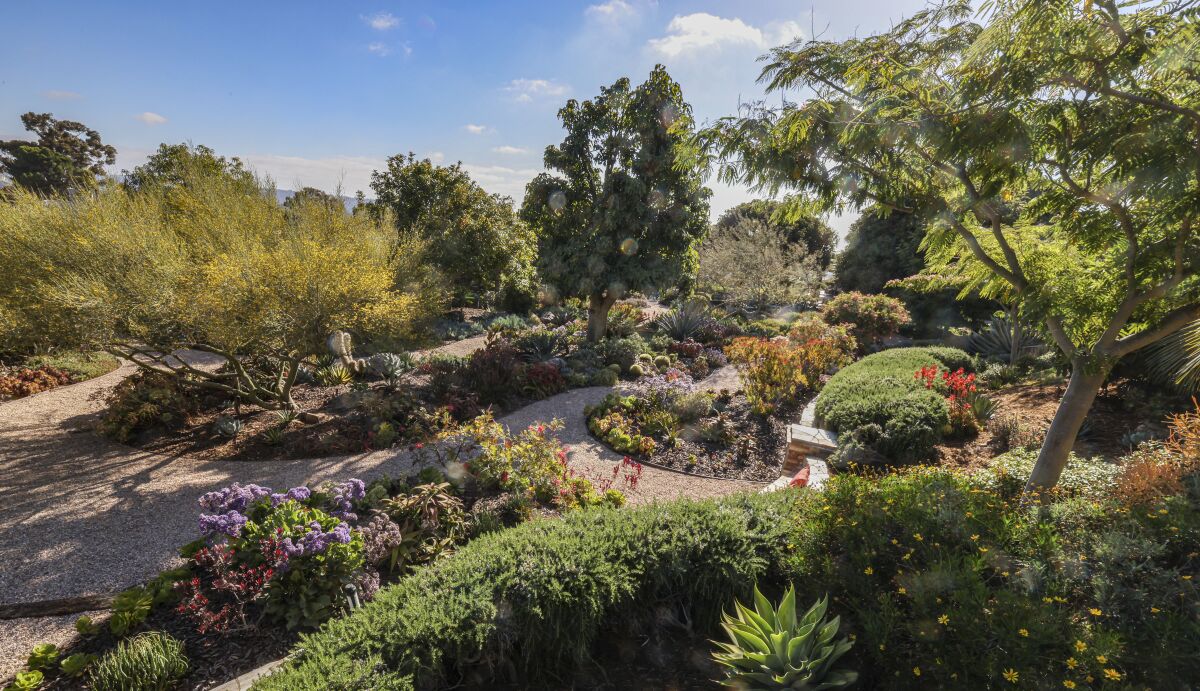
The garden is designed with paths that meander for admiring the plants and urban and coastal views of Mission Valley and Mission Bay.
(Eduardo Contreras/The San Diego Union-Tribune)
The property is located at the middle level of the convergence of several canyons and receives runoff from properties above while overlooking Heritage Park below. In drier years, drainage is not an issue, but during wet years, runoff can pose serious problems. As they readied the garden installation, they realized they had to design a comprehensive drainage system, diverting water away from both the house and garden by installing surface drains near the house, French drains under the garden and storm drains to channel the water appropriately.
As part of the drainage system, Laurie designed a picturesque dry riverbed, lined with stones and trees as habitat for birds, at the site of the former driveway at the eastern edge of the property.
Once they’d completed the new drainage system, Laurie finished laying out the garden’s “bones,” installing beds surrounded by curving pathways, filled with rock crunching musically underfoot, and a switchback stone stairway providing access to the hillside, before starting to plant. His team started nearly from scratch, retaining only three mature ficus trees (Ficus rubiginosa or rustyleaf figs) near the terrace and a few established hawthorn shrubs helping anchor the cliff by the house. They also kept and relocated all the existing yuccas to new locations around the garden.
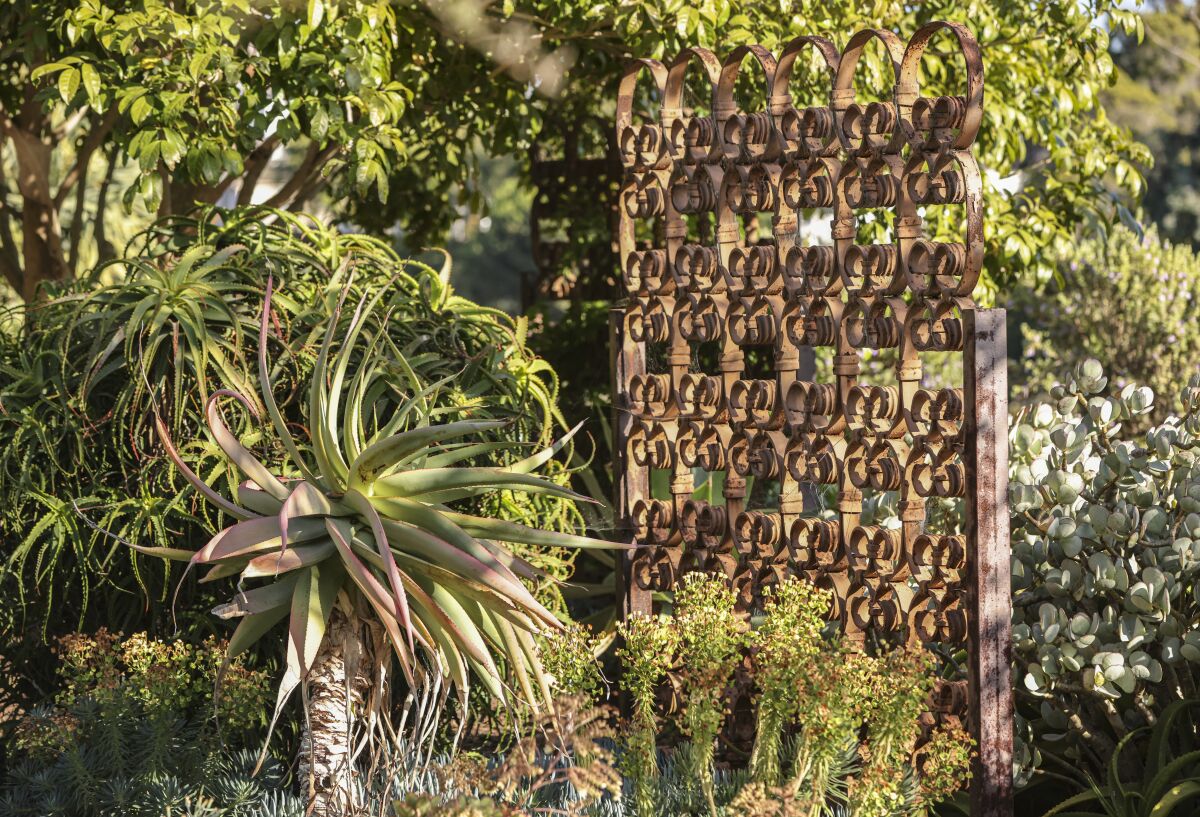
Focal points like repurposed steel gates accent the plants.
(Eduardo Contreras/The San Diego Union-Tribune)
The initial work took about 10 months, although the couple have added to the garden with incremental expansions every few years, including recent removal of the final portions of lawn near the house and additions of native plant varieties.
In designing the garden’s layout, color, texture and form in nature are key considerations while selecting the most important focal points, Laurie explained.
“When I got down to details, I wanted something new, interesting and inviting every time you turn the corner,” he said. “I wanted places to sit to absorb the garden. This is an aloe and agave specimen garden. I use a lot of Proteas and Leucadendrons and a lot of interesting and usual Mediterranean-climate plants from South Africa and Australia. It’s a garden adventure, an art gallery of plants, many of which are very sculptural.”
Throughout the garden, visitors encounter plants that are bushy, curved or spiky, and rosette-, sword- or candelabra-shaped. Fragrance wafts through the garden from assorted jasmine, Buddleja and other flowers.
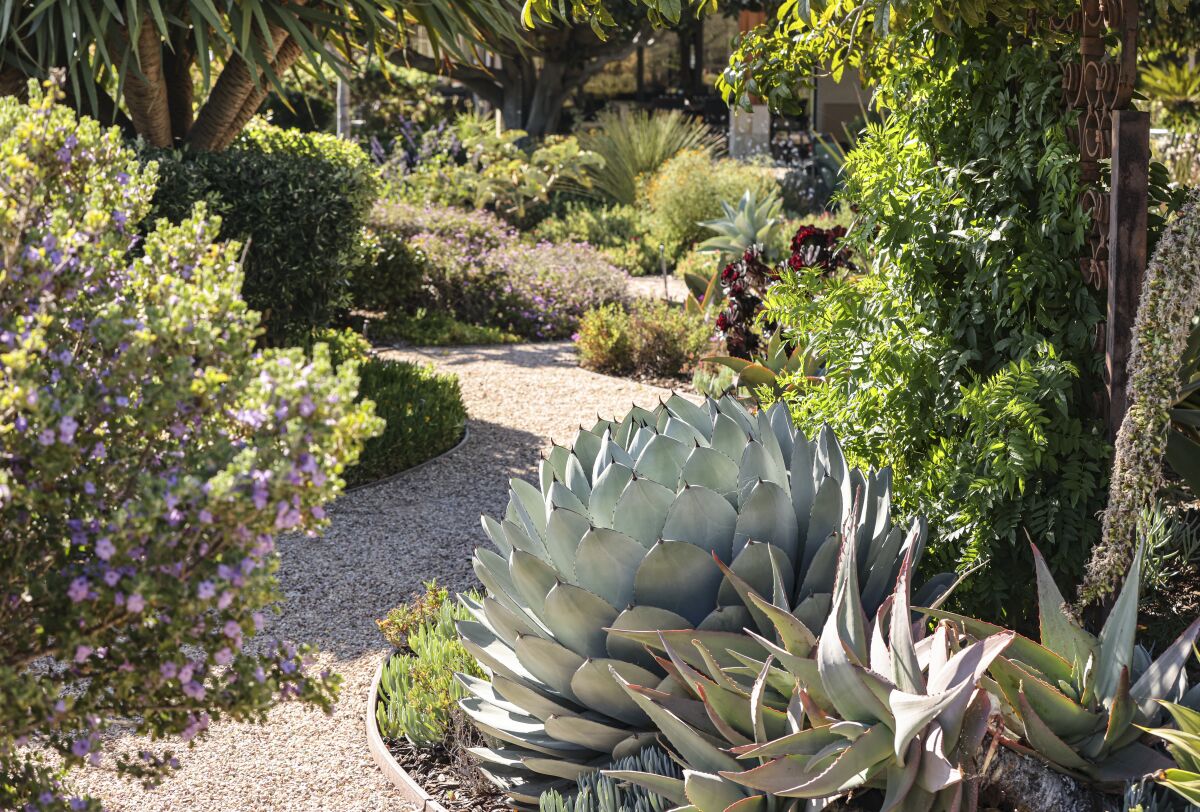
The plantings are a mature blend of texture, color, pattern and shape,
(Eduardo Contreras / The San Diego Union-Tribune)
“When you look at a garden, you may not realize there are patterns,” Laurie explained, “but your eye picks it up, patterns and echoes. I try to stay away from ‘onesies,’ single plants, except for special specimen plants or large plants.”
Among those special single specimen plants, most installed near the house, are several prehistoric and unusual plant varieties, including the sago palm; cycads, including Dioon, Encephalartos and Zamia; and the Queensland bottle tree.
In remodeling the house and installing the garden, the owners were careful to save and recycle usable elements. While they donated many still-useful building components to Habitat for Humanity, they saved three beautiful steel gates from around the house and added them as artistic focal points in the garden, accenting the plants.
The owners enjoy their outdoor space daily, working in it themselves, although they have teams of gardeners tending to maintenance. They stroll in of the expansive garden regularly, stopping to enjoy a glass of wine at one of the five seating areas, and entertaining guests around the fire pit and outdoor dining area. They also regularly invite groups to share their garden and participate in the Mission Hills Garden Walk — presented in early May — about every three years, including this year.
Laurie grew up in Hubbard, Ohio, near Youngstown, helping at his grandparents’ farm and his parents’ large garden center and commercial landscaping company, where he learned the importance of customer service and customer care — but he never planned to make a career in horticulture. He always loved plants and was the unofficial “plant doctor” at his dorm at The Ohio State University, where he studied architecture, business and computer science.
He moved to San Diego in 1982 to become a software engineer at the U.S. Navy’s Point Loma base, staying there nine years before joining a friend’s costume company to set up the information management and computer systems. He settled in North Park, where he spent his spare time learning about local and drought-tolerant plants and, especially, waterwise landscape design.
When he was laid off after 9/11, Laurie responded to friends who liked what he had done landscaping his home and who sought help with their own. Soon, he founded his own landscaping design company, specializing in low-water, low-maintenance gardens, emphasizing succulents.
“I’ve become known for the work I’ve done reimagining historical gardens and have worked on gardens which were originally installed by Kate Sessions and homes by Irving Gill, Louis Gill, Frank Meade and Richard Requa,” he said.
Most important, Laurie wants people to be able to connect with plants and the natural environment with the wonder and delight he experienced as a child.
“A garden is healing. Most people want to connect with nature,” he said.
For more information, contact Laurie’s Landscaping at (619) 251-6455.
Sours Larson is a San Diego freelance writer.


